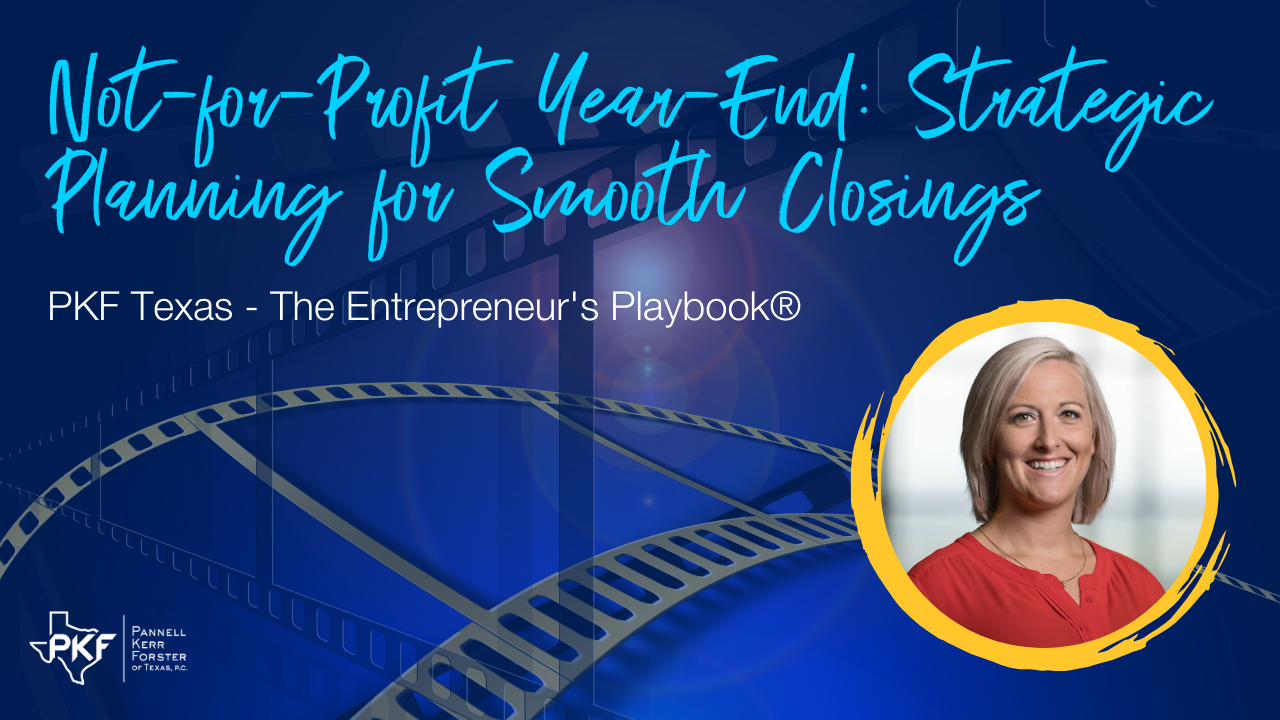Not-for-Profit Year-End: Strategic Planning for Smooth Closings

Join Jen Lemanski and Nicole Riley as they guide not-for-profit entities through strategic planning for a seamless year-end closing. Explore key considerations, including staying up-to-date on data entry, planning physical inventory counts, and implementing cutoff procedures. Learn how these proactive steps can alleviate stress, enhance accuracy, and set the stage for efficient tax preparation and audit processes.
Jen: This is the PKF Texas – Entrepreneur’s Playbook®, I’m Jen Lemanski, and I’m back once again with Nicole Riley, one of our Approachable Advisors™ and one of the leaders of our not-for-profit team. Nicole, welcome back to the Playbook.
Nicole: Thanks for having me.
Jen: So, year-end is kind of important. What do you actually mean by year-end for a not-for-profit entity?
Nicole: So, what I’m talking about is their accounting year-end or their fiscal year-end. A lot of times in the corporate role or the for-profits, that’s December, that’s the calendar year-end. But in not-for-profits, we actually see year-ends throughout the entire calendar year. I have clients that have year-ends of March, June, August, September, and of course December. So, we’re really talking about that fiscal year-end when we start talking about year-end considerations.
Jen: And so, is there anything that a not-for-profit entity should do to prepare for those year-end closes?
Nicole: So, the goal is you want your year-end closing to go as smoothly as possible. And to do that, there’s a lot of things that you can do to get ahead of the game and I think that’s really important to consider and try to do. So, the first and foremost I would say be up to date on your data entry. So, if you’re getting behind, it’s getting close to your year-end, you’re behind on data entry. Look to get help now rather than after your year-end. because it can be a lot less stressful and a lot easier to have other people help you and get that data input done ahead of time and get caught up with previous month reconciliations or details before you have to deal with the full year-end preparations, tax prep, audit prep, all that kind of thing. And then another thing that I recommend if you have inventory is plan well in advance to make sure that you have a full physical inventory count scheduled where everybody knows when it is you’ve communicated with your auditor when that is so they can be there and do your test counts you know, those kinds of things. It’s good to have that good preparation in place before you get to your year-end.
Jen: And about how far in advance if they’ve got inventory should they be doing those inventory counts?
Nicole: You want the inventory counts to be as close to year-end as possible. So, the actual count should be really close to year-end day of week, of week after, really close to that year-end. But having it planned so everybody knows that they have to be there coordinating schedules because you got to have a whole crew to help do all the counting. You just want to make sure you start planning what will in advance.
Jen: So, what other things should they be prepping for the year-end?
Nicole: Getting all your cutoff procedures, your year-end cutoff procedures in place ahead of time is good. Making sure that when you get close to that year-end, if you get a lot of donations, date stamping those donations so you know whether they came in during the last month of the year or they were actually received by the organization after year-end because a lot of times donors will put a certain date on the check that’s not the same month that the organization received it. And of course, with contributions, you record it when you receive the donation, not necessarily when the donor wrote the check or put it in the mail. And then also making sure you have those cutoff procedures for accounts payable, the expense side too, you know, starting to think about do what invoices have we not received as you’re getting close to year-end that need to be recorded but aren’t here yet. You know, if you have big projects going on, reaching out to those vendors to try to get estimates and see what’s been incurred. What do you have going on that you haven’t actually received in-house. So, you can get those properly recorded in the, in the current fiscal year.
Jen: Because they may not be thinking, they don’t necessarily know where near year-end is. They may be thinking it’s calendar year.
Nicole: Correct. Yeah. So, if you’re a June 30th year end and they’re in the middle of a project, they may not be worried about getting you that invoice right on time or they’re in the middle of the project, so they’re going to wait. So, but to get that good cutoff with them is always really important.
Jen: And is there anything that they should be doing after year-end?
Nicole: Well, of course the after year-end is when most of the work starts really happening afterwards. But if you’ve prepared and you’ve got things moving already, it could be pretty helpful. So, that’s when you do your real hard close, that’s when you make sure everything’s recorded in the right period, either in the current year or making sure it’s not included if it shouldn’t be. Making sure that you’ve reconciled all your accounts, you have all those reconciliations done, and then reaching out to your accounting firm for your tax preparation. What do they need to do that tax preparation or if you have an audit, what do they need to do that work as well. And that’s planned and on the schedule as well. And knowing when that’s going to be.
Jen: Perfect, well, we’ll get you back to talk about some more things impacting not-for-profit. Sound good?
Nicole: Sounds great.
Jen: This has been another Thought Leader production, brought to you by PKF Texas – Entrepreneur’s Playbook®. For more information about this and other topics, visit pkftexas.com/insights. Tune in next week for another chapter.

